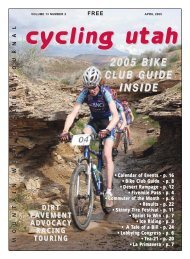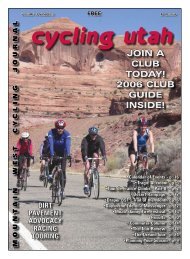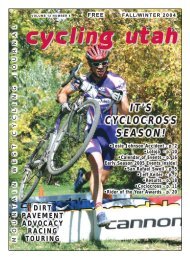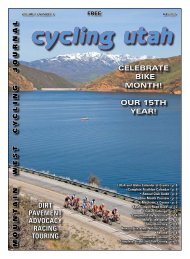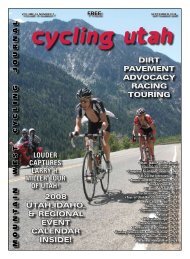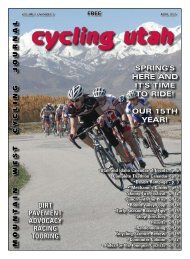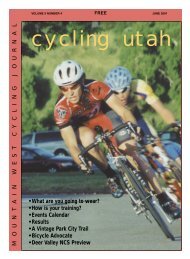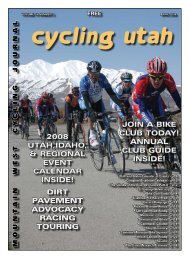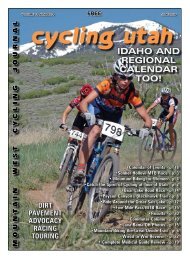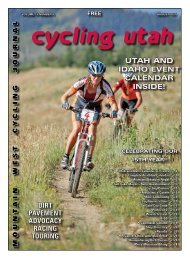Create successful ePaper yourself
Turn your PDF publications into a flip-book with our unique Google optimized e-Paper software.
JUNE <strong>2008</strong> cycling utah.com 19FILM review"Seasons" Showcases Freeride TalentBy James KirkI saw the new Collective film“Seasons” last month. The filmpremiered at Brewvie’s in Salt Laketo a packed house. For those of youwho don’t know, The Collective isa group of filmmakers and freeriderswho have united to producemountain biking films of the highestcaliber. “The Collective and “Roam”were their last 2 films; both of thesewere received with rave reviews.“Seasons”, their latest film, details7 top freeriders and downhillersthroughout the 4 seasons. Honestly,I was expecting the worst. I’ve seenjust about every freeride/downhillfilm that has come out since thesport was invented. I’ve grownvery tired and discouraged withthe genre. I expected just anotherMTV style flick depicting full-facehelmets, body armor, skidding downhills and hitting jumps to a cheesymetal and rap soundtrack, but this isa “Collective” film, it should be different,right? I was surprised. It wasa film about dudes sliding downhilland dirt jumping but nonetheless itwas presented in a very fresh, satisfyingway.The film opens with Steve Peatrecollecting on his past 3 World cupwins and how he’ll attempt to stayon top this year. Several minutes of“Peaty” sliding through the Englishmud at mach speeds gave me a newrespect for downhill racing and theexpertise required to stay at the frontof the game.Cam McCaul is up next executinginsane tricks. We see him ridethrough his neighborhood down thewrong side of the street at machspeed. We then see his trick tolearning all those absurdly, difficultstunts. Cam has built a huge towerin his backyard which he uses toget enough speed to jump into hisbackyard pool. The piece is followedby the contrast of Darren Barreclothjumping into a chilly, Canadian lake,sporting a wetsuit to tolerate thecold.The cinematography really startsto shine in the Cam’s segment. TheCollective has mastered the art ofzip-line filming. The makers of thefilm will construct a hanging hightension line over whatever sectionof trail they want to film. A cameramanis then rigged to the line to filmthe riders at high speed, up close forlong sections of trail. It translatesthe feeling of riding so much betterthan stationary filming locations. It’smountain bike footage like you’venever seen it before.The next segment is AndrewShandro reflecting on his legacy inDownhill and freeride mountain biking.But mostly the segment comesoff as him telling the audience (andhis sponsors) over and over that he’snot too old for this kid’s stuff.The “Awww Shucks” part ofmovie consists of Steve Smith beingshuttled by his mom in VancouverBC. Steve is one of Canada’s youngestup and coming downhill stars.His mom truly believes that everyshuttle ride up is one step closer toachieving her son’s goal of worldchampionship. This mom rocksevery bit as hard as anyone else inthis movie!Matt Hunter’s huge 75 foot gapis the icing on the cake. This jumpis by far one of the burliest thingsI’ve seen done on a bike. It madethe movie. The segment gets killedhowever by Matt proclaiming thevirtues of ripping up singletrack on amotorcycle. Yea, whatever Matt…The Mt Psychosis downhill raceis a 4000’ all singletrack descent.The film spends a few minutesshowing us the magnitude of therace and how difficult it is to evenfinish. The record time is just under13 minutes. Hearing the top riders inthe world complain about enduringmore than 6 minutes of effort wasworth a chuckle.The personalized segments endwith Thomas Vanderham in hisown personally constructed jumpparadise. The viewer watches as hecalculates how much speed he needsto clear a massive step-up. Thespeed ends up being faster than hecan pedal, yet somehow he stompsthe landing.The film wraps up with theCrankworx competition in Whistler.Crankworx in Whistler is theSuperbowl of freeriding. All the bestshow up. The scene concludes withall the major characters of the movieriding A-line and Karate monkey ina high speed, super-tight gravy trainof the worlds most skilled riders.All in all I liked it. It was a funmovie and it surprisingly enough gotme stoked to ride. That’s the goal ofmost bike porn, right? The cinematographywas the best I’ve ever seenin an action sports movie. I wasbummed by the unashamed dependenceon engines and bike pushingto accomplish just about everythingin this film. <strong>Cycling</strong> is about pedalingright? Anyway, enough of mysoapbox, Seasons is an outstandingfilm documenting freeride anddownhill racing at its cutting edge.The sound tracking was pleasingand appropriate rather than irritating.Scenic locations weren’t usedto carry the film but rather a mix ofgreat interviews, technically stunningfootage and the world’s bestriders doing their thing is what madeMechanic's CornerTo Tube, or Not to Tube?By Tom Jowthe film. This is how cycling filmsare supposed to be made. It’s wellworth the price of the DVD. You’llwatch it over and over.James Kirk is an ex bike shopguy turned computer guy. Findhim at mountainbikesaltlake.Find out more about"Seasons" at www.thecollectivefilm.com.What’s on your mind?Send your feedback andletters to theeditor to:dave@cyclingutah.comAt the turn of the century one of the hottest newtechnologies was the tubeless tire system. Now, it seemsto be all but forgotten. Unlike many components, thereare just not that many new developments to be made tokeep this performance enhancer in the limelight. In fact,many mountain bikes come equipped with tubeless compatiblecomponents and their owners don’t know it. Assalespeople, sometimes we even forget to mention it. Butusing a tubeless tire system can increase the performanceand enjoyment of our rides. There are two distinct typesof tubeless systems available today.In order to create a tubeless tire system, an airtightseal was needed in the rim bed. Mavic accomplished thisby developing a method of installing the spokes from thehub side of the rim, leaving the inner rim bed completelysealed. The rim bead seat was also redesigned to providean airtight seal and Universal System Tubeless (UST)was born. The tire companies Hutchinson and Michelindesigned special tires that use a stronger bead wire towithstand the increased stress of the airtight bead seal.In addition, the UST tire has a layer of rubber inside thecasing to complete the air containment.Why go tubeless? The benefits of tubeless tiresinclude lower rolling resistance, greater traction and lesspunctures. Without a tube, the rider can use lower tirepressure with less risk of pinch flats. With lower pressure,the tire contact patch is larger which provides moretraction. The rolling resistance is decreased because withthe lower tire pressure because the tire deforms and rollsover more objects instead of being deflected.However, benefits do not come without cost.Upgrading to a UST wheel set with tires will cost severalhundred dollars. Weight is always an issue on abicycle, especially when it comes to wheels. A tubelesswheel set is of comparable weight, but the tubeless tireis a little heavier than its non-tubeless counterpart withtube. Installation can be frustrating if the tire does notinflate right away. Also, air pressure of approximately60psi is needed to seat the bead completely; not an easytask without a floor pump or compressed air. Finally, thetire is still subject to punctures from sharp objects, andpinch flats can still occur if the tire pressure is too low.Instead of pinching a tube, the tire will have two puncturesin it.A lower cost alternative to UST tubeless is a tubelessconversion kit. While Bontrager manufactures a kit forits own brand, the most popular conversion kit is madeby NoTubes.com. The tubeless conversion is made possibleby a rim strip and valve combination that sealsthe rim spoke holes and provides an airtight bead seat.Therefore, any UST tire can then be used. More oftenthough, a standard tube tire is used with a liquid sealantinside.The benefits of a tubeless conversion kit are many.First, it provides all the performance enhancements ofa tubeless tire system at a much lower cost. Second, thewheels are much lighter weight if used with sealant anda tube type tire. Finally, puncture resistance is increasedwith the sealant and seating the bead is often easier.Tubeless conversion kits also have own their drawbacks.Installing or removing the sealant can be messy.Latex based sealants are prone to drying out, needing tobe “refreshed every couple months or so. Similar to USTtubeless, initial inflation and sealing can sometimes be achallenge. Tire selection is reduced due to manufacturersrecommendations.Replacing tires is often a task that no one wantsto do. New tires are not nearly as glamorous as a newshock. But look at the stacks of tires in any race truckand you will see how important tires are to performance.The correct tire and the benefits of tubeless could be justwhat you need to put a little excitement into your riding.Ten years later, what’s next? Road tubeless.Tips for Tubeless• Follow the manufacturers recommendations andinstructions.• Upon initial inflation, lubricate tire beads with soapywater. Use as little pressure as necessary to seat the beadand wear safety glasses.• When using sealant, immediately after seating thebeads, shake the tire horizontally to better distribute theliquid.• Start with initial pressure 5psi less than with tubes.Decrease slowly until comfortable or you reach 30psi.Inadequate pressure leads to pinch flats and decreasedcontrol.• When performing repairs, unlock as few tire beads asnecessary. That means one.• Inspect tire casings, treads and inflation pressureoften• Tubeless conversion for Cyclocross.Tom works at Wild Rose Sports in Salt LakeCity. He has done sales, repairs, race team supportand bicycle fitting for nearly 30 years.IMBA’s <strong>2008</strong> World Summit to beheld in Park City in <strong>June</strong>Mountain biking enthusiasts from around the globewill gather in Park City, <strong>Utah</strong>, <strong>June</strong> 18-21 for the <strong>2008</strong>IMBA World Summit. IMBA Summits bring mountainbiking advocates, land managers, ski resort professionals,trailbuilders, tourism officials and the bike industrytogether for collaboration, planning and celebration."We could not be more excited about the locationof our <strong>2008</strong> gathering," says IMBA executive directorMike Van Abel. "Park City is a model trails communityand IMBA's host club, the Mountain Trails Foundation,is also a model of shared-use leadership, with nonmotorizedgroups coming together to create amazingtrails and maybe more important, a tight-knit trailscommunity.""Park City was losing its trails to rapid development.In the course of a couple of years, we went fromtrails being an after-thought in the planning processto where trails are given equal weight with streets andutilities in new development," said Mountain TrailsFoundation founder and IMBA Board Member TomClyde. "Practically all of the trail system is on privateland, and now there is almost a competition among thedevelopment community to see who can build the besttrails. This is because an active trails community gotbehind the cause."The <strong>2008</strong> IMBA Summit will be open to the public,and will feature advocacy seminars, trailbuilding workshops,networking, great food, parties, celebrity guestspeakers and some big surprises. Topics will includethe economic power of trails, sustainable trailbuilding,liability and risk management, urban trail networks,building club capacity and much more.IMBA's most recent Summit attracted more than400 delegates from 17 nations for three days of seminarsand discussions in Whistler, BC. A compendiumof online resources can be found at IMBA's website(imba.com).



